- Home
- Instruments
- Gear
- Recording
- Lessons
- Reviews
- Blog

To the untrained eye, acoustic guitars can look very similar – they are all made of wood, they all have a soundhole and they all have strings.
However, on closer inspection, you will find many subtle and not-so-subtle differences among the most popular styles of acoustic guitar. As such, they all have different things to offer.In this article we take a look at some of the most popular sizes – working from the largest to smallest – as well as looking a who will benefit the most from using them. Let’s get stuck in!
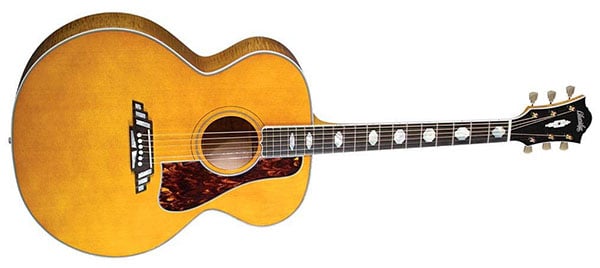
Let’s begin with the largest and loudest acoustic guitar shape on this list – the Jumbo. The Jumbo was originally introduced by Gibson in the late 1930s as the J-200, targeted towards professional players looking for a big sound. The style hit its peak in the middle of the 20th Century and, while they are less popular today thanks to the advances in acoustic amplification systems, Jumbos are still on sale and still very much in use.
Expect widths of up to 17” on the lower bout, which provides huge projection and a high volume ceiling, meaning it can produce louder sounds without distorting. You will often find more elaborate decoration on Jumbos compared to other styles, including specially-designed bridges, fretboard inlays and headstocks.
When it comes to tone, a Jumbo is generally very well-balanced with a big low-end boom. Known as the traditional ‘cowboy guitar’, Jumbos are particularly popular with country players and were a favorite of Elvis Presley, who used this style throughout his career.
Great for: Players who want to perform to a larger group of people with no additional amplification. Also, due to the high volume ceiling, Jumbos will suit aggressive strummers very well indeed.
Not so great for: Because of the bigger size, Jumbo acoustics won’t be very comfortable for smaller players (especially children), while their hefty projection means they aren’t the best style for quiet practice sessions. They are also a little more cumbersome to travel with.
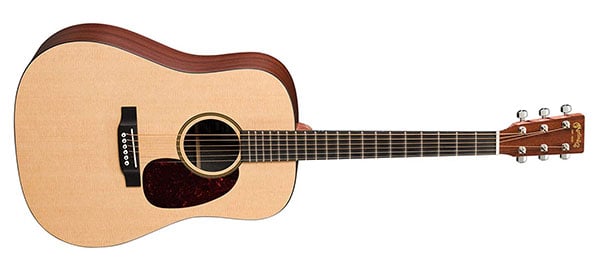
Next is a real classic and the most popular of acoustic guitar body shapes, used for both budget guitars as well as the most expensive Martin and Taylors. Seriously, walk into any guitar store and chances are the first guitar you see will be a Dreadnought.
The Dreadnought was created by Martin in 1916, who named the guitar after the massive British battleships. Of course, this was to reflect the big build of a Dreadnought guitar, with its large, wide soundboard. Typically, a Dreadnought will have a body length of 20” and a width of 16”, with a scale length of 25.4”.
Due to the larger shape, a Dreadnought will produce a bold, balanced sound with a powerful low-end, snappy midrange and bright trebles. This makes it popular with rock, country and bluegrass players in particular.
Great for: As the volume ceiling is so high, a Dreadnought is a great fit for aggressive strummers and flat-pickers, especially those who want a strong low-end.
Not so great for: You can play fingerstyle on a dreadnought, although this certainly isn’t the optimum fingerstyle guitar. Also, due to the larger body size, Dreadnoughts are not as comfortable to hold for smaller players, including children.
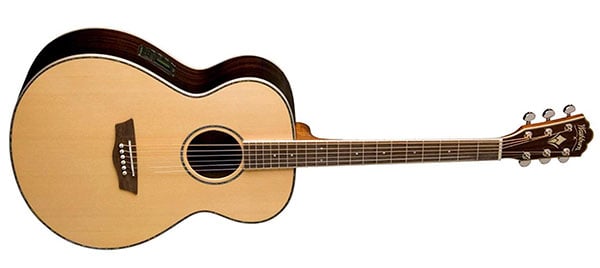
Aside from the Dreadnought, the Auditorium (originally introduced by Martin) and Grand Auditorium (a Taylor creation) guitars are perhaps the most popular styles of acoustic in today’s market, mainly thanks to the versatility in tone and performance they provide.
In terms of size, these guitars sit roughly between a Dreadnought and a Concert (below), with a typical lower bout width of around 15” (Auditorium) to 16” (Grand Auditorium). Compared to a Dreadnought, they show off a narrower waist, making them very comfortable to play while seated.
Auditorium acoustics offer a warm, clear and well-balanced tone and make for a great all-rounder, coping very well with strumming, flatpicking and fingerstyle. As such, they prove popular for all styles of music, from rock and blues to country and folk.
Great for: Players wanting a multi-purpose guitar suitable for all styles of music and styles of playing. Also, very good for those with a lighter touch. With a pickup/preamp system, they are also one of the nicest sounding guitar styles plugged in.
Not so great for: The most aggressive strummers may find the lower volume ceiling hard to work with.
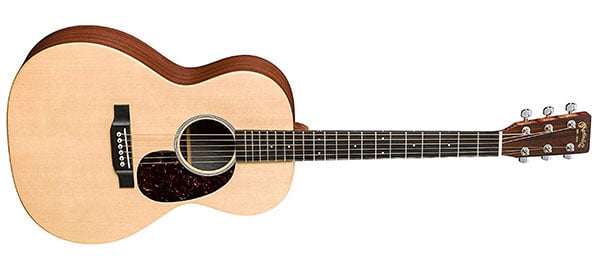
Although not quite as petite as the Parlor (below), a Concert acoustic is one of the smaller acoustic varieties in production today. Also known as an ‘O’ sized guitars (where Martin is concerned), a Concert acoustic sits somewhere between a Dreadnought and a classical guitar in terms of design, with a slightly shorter, slightly narrower body and a typical lower bout width of 13.5”.
Like Auditoriums, they also have a narrower waist compared to a Dreadnought, which makes it very comfortable to play with while sitting down. Concert acoustics are also a little shallower in depth, leading to a slightly quieter sound. With less bass response, Concerts tend to have a robust mid-range and clarity in the treble.
As you may expect, a Grand Concert is just a slightly bigger Concert guitar, with a typical lower bout width of 14” to 15”. Ultimately, they offer a marginally bigger sound, but lose some definition because of it.
Great for: Due to the smaller size, a Concert acoustic is a great choice for smaller players who don’t want the vintage/boxy tones of a Parlor guitar (see below). Plus, with such an articulate tone, a Concert acoustic is a favored style for fingerstylists.
Not so great for: Aggressive strummers will suffer, as the low volume ceiling means the sound will distort as the volume increases.
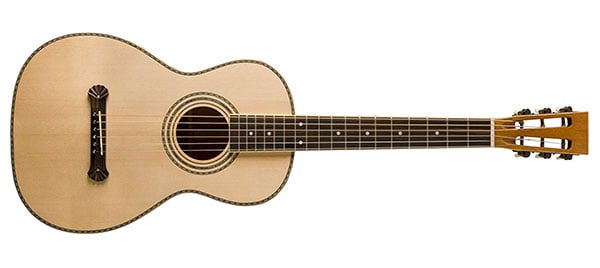
At the opposite end of the size spectrum to a Jumbo, you will find the petite Parlor guitar, which rose to fame in the late 1800s. While its popularity dwindled from the 1950s onwards, these models still have their fans and are still made today by brands such as Fender, Washburn and Ibanez.
This compact style of guitar tends to have a small overall length and an elongated body, retaining a standard nut width to make them suitable for all styles of playing, from strumming to fingerstyle. Tonally, a Parlor guitar is light, focused and quite well balanced, although with less bass and more midrange emphasis.
It also offers the ‘boxy’ sound that vintage players love, which is one of the reasons Parlor guitars are still popular today, appealing to blues, slide and folk players in particular. Of course, they are naturally quieter than big-bodied acoustics too.
Great for: Parlor guitars are great for smaller players and children as their reduced size makes them easier to hold, although full-sized adults shouldn’t snub this style if they want that boxy, vintage tone. Parlors are also a good call for singer-songwriters, as the lighter projection means you don’t have to compete with the guitar when playing. This style is also great for players on the move, as a smaller guitar is easier to travel with.
Not so great for: Tone purists may not appreciate Parlor guitars, as they lack a wide dynamic range. Also, because volume is curbed due to the smaller size, performing acoustically to a large crowd may be also prove tricky.
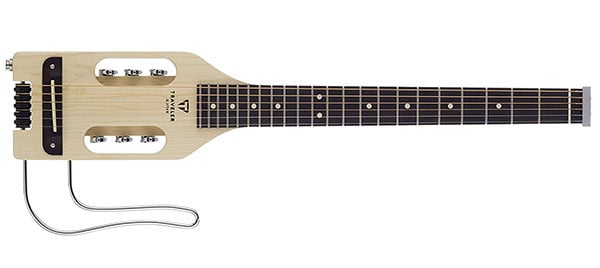
While the Parlor guitar is the smallest of the traditional acoustic guitars, there is a wide range of travel acoustics that are hugely popular.
The majority of these feature a full-size fretboard, a close to full-size scale length (around 23”) and a very similar playing experience to a full-size guitar. In short, while they may be small and cute, they are not toys. In fact, some can cost much more than a standard acoustic!
Traditional shapes go out the window in this category. Of course, you can find the Little Martin or the Baby Taylor, which both look like mini guitars, but next to these you may find something like the Traveler Guitar Ultra-Light, which is completely different!
Most travel guitars will be made of laminated woods to ensure they are light and resistant to temperature and humidity changes. They don’t sound bad but tonally they are nothing compared to a full-size acoustic guitar, while the projection can be very soft due to the small bodies.
Great for: Obviously, these guitars are great for travel, whether you are heading across your city on the bus or around the world in a plane. Most of them will come with their own gig bag too, which makes them instantly transportable. This style of guitar is also good for quiet practice due to the curbed projection.
Not so great for: Just like a Parlor, seekers of great tone will find little pleasure in a travel guitar. They are also notoriously quiet, so are not suitable for performances to more than a handful of people. They can also be a little tricky to play if you are a bigger player.
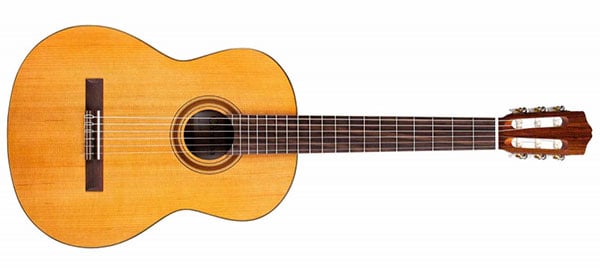
In a category of its own is the classical guitar, which is a nylon-stringed acoustic (compared to the rest on this list, which feature steel strings). Classical guitars are made by many manufacturers around the world, although they are specialties of brands such as Cordoba, Kremona and Yamaha.
A typical classical guitar differs from a steel-string acoustic in many ways. For example, the neck and fretboard are wider on a classical guitar (usually with a nut width of around 2” or more) providing a more spacious surface area to play with. This surface area is also flatter, compared to the radiused fretboard of a steel-string acoustic.
In terms of scale length, a classical guitar tends to be a bit longer than a steel-string acoustic at around 26”. Style-wise, nylon-stringed models are usually joined to the body at the 12th fret and feature a slotted headstock with open-geared tuners.
Great for: This is an easy one – classical guitarists! Or any player who wants the softer, balanced sound of nylon strings including Spanish, fingerstyle and Flamenco players. This style of guitar is also seen as a good choice for beginners, as the strings are easier on the fingers.
Not so great for: Flat-pickers and strummers won’t enjoy the experience of a classical guitar as much, while traditional steel-string songs will always sound a little weird played with nylon strings. Players with small hands may struggle making chords due to the larger fretboard, although if this is the case, several ¾ and ½ sized classical guitars are available.

Reader Interactions